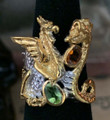 Loading... Please wait...
Loading... Please wait...WIN A KARAMBIT!
Price:
$1.00
Condition:
New
Weight:
500.00 Grams
Shipping:
Free Shipping
Product Description

~ Here's the Deal ~ ©
Uncle Waddy won a lot of six of these knives at auction without prior inspection. The boxes do not match the knives. They are new and suitable for gifts or your own use.
We will hold six individual drawings, one for each of these knives.
The $1 Drawing donation will be going to Dogs and Cats Forever, our local No Kill animal shelter.
No Other Purchase Necessary, BUT! Add this to ANY Lot Purchased Through This Website and we will add $5 to YOUR DONATION AND ENTRIES, giving you SIX (6) chances to win!
~!~
Karambit
The karambit or kerambit (as used in Indonesian), kurambik or karambiak (both from the Minangkabau language) is a small curved knife resembling a claw. It is most closely associated with the Minangkabau people of West Sumatra, Indonesia, but is also found throughout other ethnic groups in Southeast Asia. The karambit is one of the weapons commonly used in pencak silat and Filipino martial arts.
Origin
The karambit was originally an agricultural implement designed to rake roots, gather threshing and plant rice in most of island Southeast Asia. It's a smaller variant of the Southeast Asian sickles (Indonesian celurit, arit, or sabit; Filipino garab and karit; and Malaysian sabit). It still possesses many efficient uses for the modern laborer, allowing use of the blade for utility work, with the finger ring eliminating the need to put the knife down between operations, if use of the fingers to manipulate the object to be worked on is required (such as the action of cutting and opening a shipping box, or removing plastic wrap from shipments, in two very basic examples). The finger ring also provides an added degree of protection against dropping the knife during use, which is particularly essential in work environments that include heavy machinery, into which dropping a handheld, metal tool of any kind can cause massive damage to the equipment and those around it, especially if the tool is ejected at high velocity from rotating components.
The karambit is believed to have originally been weaponized among the Minangkabau people of West Sumatra where, according to folklore, it was inspired by the claws of a tiger. As it was weaponised, the blade became more curved to maximise cutting potential. Through Indonesia's trade network and close contact with neighboring countries, the weaponization of the karambit was eventually dispersed through what are now Malaysia, the Philippines, Thailand, Cambodia, Laos, and Myanmar. European accounts tell that soldiers in Indonesia were armed with a kris at their waist or back and a spear in their hands, while the karambit was used as a last resort when the fighter's other weapons were lost in battle. The renowned Bugis warriors of Sulawesi were famous for their embrace of the karambit. Today it is one of the main weapons of silat and is commonly used in Filipino martial arts as well.
Superficially, the karambit resembles the jambiyah, although there is no connection. The jambiyah was always designed as a weapon and serves as a status marker, often made by skilled artisans and jewelers using precious stones and metals, whereas the karambit was and still remains an unadorned farmer's implement and utility knife.
Technique
The karambit is held with the blade pointing downward from the bottom of the fist, usually curving forwards. While it is primarily used in a slashing or hooking motion, karambit with a finger ring are also used in a punching motion hitting the opponent with the finger ring. Some karambit are designed to be used in a hammering motion. This flexibility of striking methods is what makes it useful in self-defense situations. The finger guard makes it difficult to disarm and allows the knife to be maneuvered in the fingers without losing one's grip. The short Filipino karambit has found some favor in the West because such proponents allege the biomechanics of the weapon allow for more powerful cutting strokes and painful "ripping" wounds, and because its usability is hypothesized as more intuitive, but more difficult to master than a classic knife.
Variations
There are many regional variants of karambit. The length of the blade, for example, could vary from one village or blacksmith to another. Some have no finger guard and some feature two blades, one on each side of the handle. Modern karambit may have spikes or spurs on the front or rear ricasso, which may be intended for gripping clothing or horse tack, tearing flesh or for injecting a poison, such as the upas.
Modern Forms
The modern Western interpretation of the karambit is far removed from the original agricultural tool. They may have folding blades, are finished to a high standard, made from expensive materials as opposed to being rudimentary and makeshift and are generally larger to accommodate larger hands giving it pure shape.
~!~
Nice addition to any collection, altar, wardrobe or decor, displays really well.
Good Luck!
~!~
Really doesn't get any better than this.
There are 7 photographs below that tell the rest of this tale.
Shipped free of charge via Insured Ground Shipping.
Rest assured your order will be carefully packed to withstand the onslaught of the most deranged of Carriers.

©Text and Photos Copyright 2024 bushidobuce, all rights reserved.
~!~


















